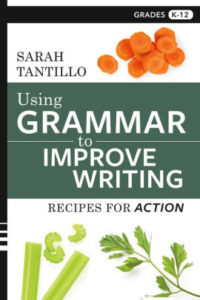Help Students Explain Their Ideas in Writing

Sarah
By Sarah Tantillo with Bianca Licata
Probably the most common problem we see in students’ writing at every level is their struggle to explain. Even students who can generate a claim or argument and find relevant evidence still struggle to articulate how the evidence supports their argument.
Some students do not even realize that they should explain their ideas, and we have to convince them to (as I have written about here).

Bianca
Recently I sat down with 8th grade ELA teacher Bianca Licata to analyze the problem of ineffective explaining in student writing. We identified some causes and potential solutions, and then she began to test our ideas.
Reason #1: They feel paralyzed by formulas.
One reason students struggle to explain is that they feel constrained by writing formulas. Teachers might believe it helps to scaffold the work by giving students formulas such as “RACER” (Restate, Argue, Cite Evidence, Explain, Raise Insights), but students often take these formulas too literally and are afraid to diverge from them, so when they want to say something that doesn’t fit the formula, they feel paralyzed.
While these formulas can be valuable for students to fall back on when expected to produce a particular type of writing under time constraints (e.g., PARCC testing), good writers do not adhere strictly to formulas.
In good writing, even one sentence might include both evidence and explanation. For example, in “There is never enough room for all of the textbooks, workbooks, independent reading books, binders, and notebooks, much less the pens, pencils, and erasers,” the first five words function as explanation while the remaining items qualify as evidence.[1]
We need to show students good writing that is not formulaic and analyze what makes it good. We need to ask, “What do you like about that sentence?” and encourage students to imitate exemplars (Note: It also helps to give them an exemplar and a non-exemplar and ask them to explain why they prefer the exemplar).
But before we give them a model to work with, we need to encourage them to have the confidence to express their original ideas on the page, pressure free. And how do we help them develop write-able ideas in the first place? This brings us to the second major problem at play.
Reason #2: They conflate “How” and “Why.”
Many students combine “how” and “why” in their explanation. This problem goes back to the Grade 2 Reading Standard #1 (“Ask and answer such questions as who, what, where, when, why, and how to demonstrate understanding of key details in a text”), which I consider not only the most important reading standard but also the most important writing standard, as I’ve explained here. In brief: you must be able to answer “how” and “why” questions in order to infer and explain. If you can’t, your writing will be “listy,” not explanatory.
Many students can answer “why” questions with “because,” but they don’t know what to do about “how” questions. This is partly our fault as teachers: If you ask a “how” question and allow students to answer with “because,” you are accepting an inaccurate response and, even worse, teaching the whole class the wrong thing.[2] Too many students become comfortable with “because” and use it as a default, especially when they are given an argument that they have to support, when it is not obvious that the question being asked is a “how” question.
The other day, a teacher asked students to support this argument about a text they’d read: “Martin is a vicious bully.” Although they came up with useful, relevant evidence, they explained it incorrectly. For example, they wrote, “He shows he’s a bully because he spits on people,” which seems to answer a “why” question, but this is not why he’s a bully. The text doesn’t explain why he’s a bully; it only shows how he is (i.e., by spitting on and punching people). To use the evidence logically, they would have to write: “He shows he’s a bully by [describe his actions here].”
To address the how/why conflation challenge, we need to do two things: 1) When we give students a prompt or an argument to support, we need to ensure that they are aware of the implied question. We should ask them: Is this asking a “how” or a “why” question? 2) We need to give students “how” verbiage. Bianca and her colleagues and I took five minutes in a meeting to generate a variety of “how” responses. Here are just a few:
HOW Verbiage: How to Answer “How” Questions
- The character demonstrates this by…
- The character’s actions/dialogue/thoughts/description show that ….
- We see how…
- She makes this clear by…
- The author develops this idea by…
- The speaker expresses this view by…
- The author develops the theme by constantly using examples of…
- These steps explain how…
IN PRACTICE:
Bianca took this list a step further and customized some language to fit the assignment her students were working on, a five-paragraph essay evaluating whether or not a Greek mythological figure of their choosing was a hero according to Joseph Campbell’s tenets of heroism:
- The character demonstrates he/she is/is not a hero by…
- The character’s actions show that he/she is/is not a hero by…
While students struggled to incorporate these stems independently, they nonetheless made attempts. Prior to this assignment, students reviewed in several iterations how a figure is characterized by the author’s use of concrete traits (physical appearance) and abstract traits (thoughts, ideas, feelings, reactions, choices). Students were able to articulate how the characters demonstrated heroism through their combined traits, but in the final paper fell back on explaining why. Bianca concluded they would need more practice with the “how” verbiage.
Also, although students wanted to express their opinions clearly, there was a dissonance between how they (clearly) verbalized their claims and explanations versus what they wrote (less cogently) on the page. Often what they wrote minimally reflected what they were able to articulate in conversation. This struggle pointed to a third problem.
Reason #3: They need to hear what they think.
Whether they are extroverts or not, students tend to need to hear what they think in order to know what they think. During writing conferences, I’ve often found that when I point to a sentence and ask, “What were you trying to say here?” they can immediately say something coherent, no matter how garbled their writing was. While some may have processing issues, most simply need to talk through their ideas a bit—to hear their ideas—in order to translate them into print.
Bianca and I decided to emphasize this point in several ways. First, we would bring this phenomenon to students’ attention during writing conferences so that they would consider “talking to themselves” as a strategy when writing—i.e., that they should listen to their inner voice or whisper to themselves to bring out their ideas.
Second, we would continue to utilize frequent turn-and-talks to give students opportunities to rehearse with a partner. And third, we would launch prewriting “Peer Café Talks”—called that because students would speak in a café-level voice and carry on a casual conversation as if they were in a café, but keep it “academic.” At a basic level, this meant students would talk to a partner about what they wanted to say, then write that down.
IN PRACTICE:
Bianca designed a Do Now to invite students to reflect as follows:
Think of a time when you and someone else talked through a difficult problem (any problem!), discussed it and found a reasonable conclusion (any conclusion!), or verbally shared ways to start writing. Did talking through your issue with someone help you, and if so, how? Explain. Write for the entire Do Now time!
She needed to clarify for students what “problem” meant. Some students said, “I don’t have problems with people,” immediately assuming “problem” meant “confrontation.” In response, she prompted students to think of problems they may have encountered in, say, math class, or science, or even in writing when they struggle to get started. After this, students perked up, and a resounding “Oh!” told her they got it.
After about 5 minutes, the class discussed their responses, which varied between arguments they’d had with parents to trying to understand Algebra. Everyone reached the conclusion, however, that sometimes we might know our own arguments/thoughts, but others don’t, and it takes time and conversation to figure out how to solve a problem.
From here, she asked students to raise their hands if they’d ever had a hard time putting their thoughts on the page, or if they’d ever conferenced with her or another teacher who told them after talking through their thoughts, “That’s great! Write exactly that!” Most students raised their hands. She then walked students through the “interview” questions [download Handout #1] they would ask one another.
BACKGROUND NOTE: Prior to this activity, students had read “Phaethon,” “Pegasus and Bellerophan,” “Otus and Ephialtes,” or “Daedalus” from Mythology by Edith Hamilton. They had used a narrative organizer to plot the parts of the narrative, including the protagonist’s concrete and abstract traits in order to track how the character changed as a result of key events.
On the day of the Peer Café Talks, students used their prewriting organizer and their books to answer questions.
Bianca based the interview questions on the rubric-checklist that she would eventually use to score their essays (it’s in Handout #1). Students sat diagonal to one another, two students per table, with their laptops open. Using Google Docs, she shared the “Peer Café Talk” table with discussion questions (Handout #1) with all students, but only one in a pair opened the file, renamed it, wrote their names on it, and re-shared it with their partner. Students would take turns interviewing one another and typing their partner’s responses in the table.
Here’s a completed student sample [download Handout #2 ].
Bianca noted some challenges she had not anticipated:
1) Sometimes a pair consisted of someone who had read and someone who had not. This left the person who had read to conduct their own café talk, which defeated the entire purpose of talking.
Solution: Make sure people are paired with someone else who is prepared. Everyone else who isn’t prepared needs to do the reading or complete an alternate assignment.
2) Students need to discuss different stories. Students who chose the same story often shared the same belief that the protagonist was not a hero and had the same reasons for why their protagonist was not a hero, so they found it difficult to respond to the questions differently. She told them to paraphrase one another and to push the conversation, but it was still a challenge.
Solution: Make sure students have different stories, different opinions, or different characters that they are choosing to analyze. There needs to be some disagreement in order for the questions to be genuine.
From Prewriting to Writing/Revising:
After the 8th graders completed their Peer Café Talks, Bianca showed them how to copy and paste their ideas onto a separate document where they would use the rubric to revise their essay. Revising their ideas into an essay took some time. They had difficulty understanding how to use their rubric-checklist as a template for organizing their thoughts; they struggled to believe that all they needed to do was copy and paste, then revise.
Once they accepted that the task was as simple as that, they had a much easier time revising, and several students who had previously struggled with essay writing produced noticeably more robust, clear writing. Read essays from the two students featured in Handout #2 and Bianca’s responses to them here: Partner 1 and Partner 2.
By contrast, for students who (for one reason or another) were unable to complete their Café Talks, writing the essay was much more difficult, and some did not finish. Bianca needed to sit with them one on one to help them complete the assignment.
The Peer Café Talks approach seems promising!
Of course, students must walk through this process multiple times before they internalize the underlying concept. Bianca and I agree that it’s a worthwhile investment of time. By taking the leap to talk through their ideas, students can strengthen their writing in lasting ways.
[1] This sentence is drawn from my “desk paragraph” demo lesson in Using Grammar to Improve Writing: Recipes for Action (Bookbaby, 2018), pp. 21-27.
[2] For more on this topic, see Doug Lemov’s explanation of the technique “Right Is Right” in Teach Like a Champion 2.0: 62 Techniques That Put Students on the Path to College (San Francisco: Jossey-Bass, 2015), pp. 100-107. You can also explore Lemov’s Field Notes on “Right Is Right” here.
_____________________________________________

Bianca Licata is in her fifth year of teaching. Currently she teaches 8th grade ELA at Great Oaks Legacy Charter School in Newark, NJ, and she is pursuing an Ed.D. in Curriculum & Teaching at Teachers College.







































Great article. Thanks.